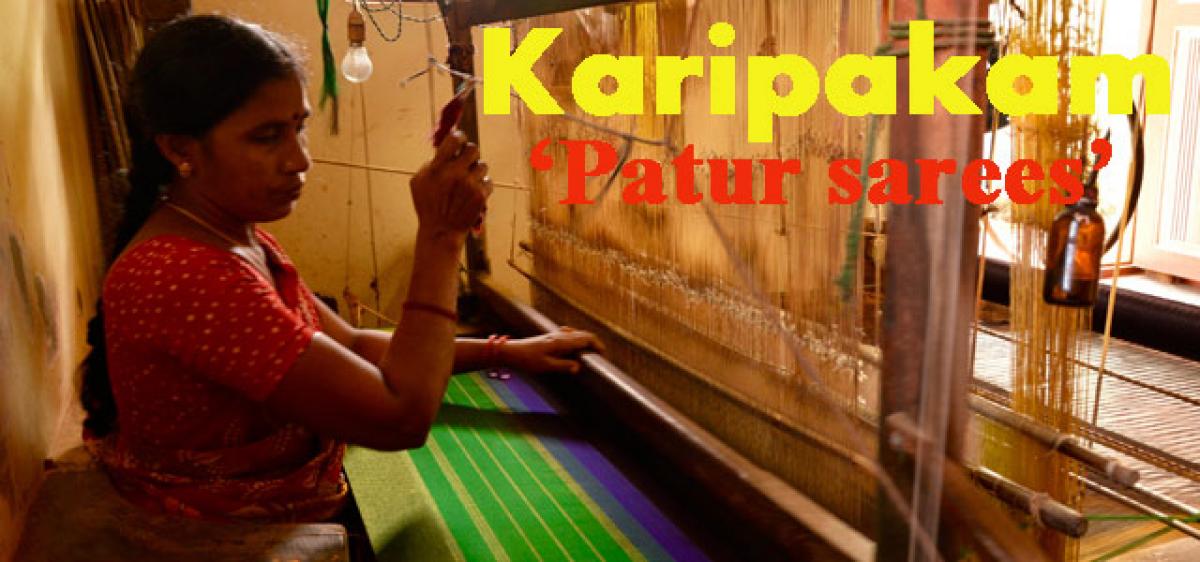Live
- National Energy Conservation Day 2024: Date, Importance, and Easy Ways to Save Energy
- Gastronomic trouble: After 'disappearing' samosas Himachal CM in row over red jungle fowl
- Meaningful dialogue a priceless jewel of democracy: Jagdeep Dhankhar
- CM Revanth Reddy Advocates for Gurukuls as Talent Development Centers
- Zepto’s expenses surge over 71 pc in FY24, losses at Rs 1,248 crore
- Tim Southee matches Chris Gayle's six-hitting record in his farewell Test
- AP Mnister Ponguru Narayana Inspects Highway Connectivity Roads to Amaravati
- Reduced inflow: Water levels in Chembarambakkam, Poondi reservoirs drop
- Slapgate haunts CM as Rohini slams Nitish following Patna DM’s action against BPSC candidate
- Amazon Music India Unveils 'Best Of 2024’ Celebrating Top Hits, Artists & Podcasts
Just In

Patur Sarees: South Indian Silk Sarees have always been known for their elegance. Be it from Telangana, Andhra, Karnataka or Tamil Nadu, every saree is unique in its design and technique to the region.
In the Chittoor district of Andhra Pradesh is a busy little village called Karipakam, where live the weavers, who bring to us the 'Patur sarees'. It makes for an ideal destination for a road trip and also to indulge in some retail therapy
South Indian Silk Sarees have always been known for their elegance. Be it from Telangana, Andhra, Karnataka or Tamil Nadu, every saree is unique in its design and technique to the region.
These sarees are usually eponymous of the region they come from. One such is the 'Patur Sarees', which is quite a in fashion today. Cotton, Silk, and Zari (gold thread) threads are hand-woven together to craft these beautiful cotton silk sarees from the village of Patur in Nellore district and the adjoining village of Karipakam in Chittoor district.
I was in Tada for the annual 'Flamingo Festival' that happens in January every year, celebrating the arrival of flamingoes to Pulicat Lake and the nearby Nelapattu Bird Sanctuary. With some time to kill before our train to Hyderabad in the late evening, I decided to take my mom shopping. To be honest I myself was a little intrigued by this village of weavers that the locals kept talking about. So off we went, asking for directions along the way, to Karipakam.
At first glance, the village looked deserted but after a bit of asking around, we were surprised by the activity all around. Every house has the traditional wooden loom installed in their biggest room and all the family members quietly go about doing their individual tasks that eventually add up to complete a saree.
Every villager here in Karipakam is traditionally a weaver. Since the mainstay of the village is this craft, all the villagers/weavers get together every morning to dye silk and cotton threads sourced from different places. It is a sight to see, this communal getting together to work.
So, if you wish to see the weavers at work, do visit the village on a sunny morning. Sunny mornings, for even the weather, need to be conducive. Too much moisture in the air dampens the thread which makes it difficult for the colour to stick.
The dyed and ready threads are then smoothened out and rolled onto spindles. Once, the patterns and the spindles of thread are ready, they are loaded onto the loom and the weaving begins. Keeping with the trend and also the rules set by the buying companies, design is not usually repeated.
Zari motifs are hand-woven into the saree, which takes 2-3 days to finish depending on the number of colours in the pattern. If the same saree were to be made on a power loom, these would have to be sewn on to the saree separately.
This is what sets these gorgeous lightweight sarees apart. The beauty of these handcrafted sarees is not just the continuity in the pattern but also the fact that there are no zari threads sticking out.
There were around 150 weavers in Karipakam once. Today there are only 50, the lack of patronage pushing them to find work in nearby factories. Even the working conditions are not much to speak of.
Though the death of threads and getting them ready is more of outdoor activity, the actual weaving is done in a pit loom. What little work now comes into the village comes from the head weaver, who gets designs from specialty retail stores and distributes it amongst the weavers.
These skilled weavers, who get to together to handcraft these beautiful silk-blend cotton sarees which are then sent off to the Nallis of the world, definitely could do with a little encouragement. Starting at Rs 2,500, these sarees can be bought directly from the weavers' houses.
Fact File
The most convenient way to get here is by road, either driving down from Tirupati or Tada. Either way, it takes between half an hour to an hour. From Hyderabad, it is an 8-hour drive to Karipakam, which is 570 km away.

© 2024 Hyderabad Media House Limited/The Hans India. All rights reserved. Powered by hocalwire.com







